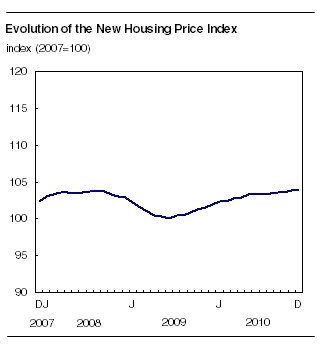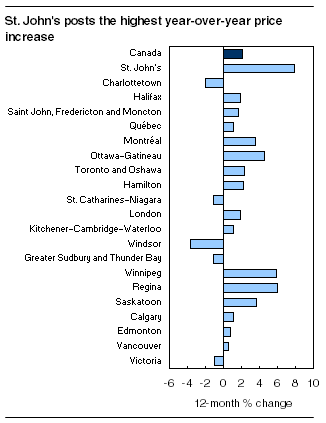New Housing Price Index
Archived Content
Information identified as archived is provided for reference, research or recordkeeping purposes. It is not subject to the Government of Canada Web Standards and has not been altered or updated since it was archived. Please "contact us" to request a format other than those available.
Related subjects
-
[an error occurred while processing this directive]
The New Housing Price Index (NHPI) rose 0.1% in December, following a 0.3% advance in November.
Toronto and Oshawa, as well as Winnipeg were the top contributors to the NHPI increase in December.

Between November and December, prices increased the most in Winnipeg (+1.1%) followed by Halifax (+0.3%) as well as Toronto and Oshawa (+0.2%).
In Winnipeg, prices rose as a result of the introduction of new building code regulations in Manitoba.
In Halifax, the increase was attributed mainly to higher material and labour costs.
The largest price decreases were recorded in Windsor (-0.6%) followed by Montréal and Québec (both down 0.3%).
In Windsor, prices declined as builders offered incentive packages in order to stimulate sales.
In Montréal, as well as in Québec, builders reported lower negotiated selling prices in December.
Year-over-year, the NHPI was up 2.1% in December following a 2.3% increase in November. The year-over-year NHPI has been registering positive changes since January 2010.
The main contributors to the year-over-year increase of the NHPI in December were the metropolitan regions of Toronto and Oshawa, Montréal and Ottawa–Gatineau.

For the second month in a row, the largest year-over-year increase was recorded in St. John's (+7.9%), as energy and mining development in the province have contributed to increased demand in the housing market.
Compared with December 2009, contractors' selling prices were also higher in Regina (+6.0%), Winnipeg (+5.9%) and Ottawa–Gatineau (+4.5%).
Among the 21 metropolitan areas surveyed, 5 registered 12-month declines in December: Windsor (-3.7%), followed by Charlottetown (-2.0%), Greater Sudbury and Thunder Bay as well as St. Catharines–Niagara (both down 1.1%) and Victoria (-1.0%).
Note: With the publication of the Decembe 2010 reference month, the base year of the New Housing Price Index is changed from 1997 to 2007.
The New Housing Price Index (NHPI) measures changes over time in the selling prices of new residential houses agreed upon between the contractor and the buyer at the time of the signing of the contract. It is designed to measure the changes in the selling prices of new houses where detailed specifications pertaining to each house remain the same between two consecutive periods. The prices collected from builders and included in the index are market selling prices less value added taxes, such as the Federal Goods and Services Tax (GST) or the Harmonized Sales Tax (HST).
The HST came into effect July 1, 2010, in Ontario and British Columbia. Prior to the introduction of the HST, the provincial sales tax on building materials in Ontario and in British Columbia was embedded in the contractor's selling prices of new houses. With the introduction of the HST in these two provinces, the provincial sales tax is now replaced by the HST, a value added tax which is conceptually excluded from the index.
This release presents data that are not seasonally adjusted and the indexes published are final.
Available on CANSIM: table 327-0046.
Definitions, data sources and methods: survey number 2310.
The fourth quarter 2010 issue of Capital Expenditure Price Statistics (62-007-X, free) will be available in April.
The new housing price indexes for January will be released on March 9.
For more information, or to enquire about the concepts, methods or data quality of this release, contact Client Services (613-951-4550; toll-free 1-888-951-4550; fax: 613-951-3117; ppd-info-dpp@statcan.gc.ca), Producer Prices Division.
- Date modified:
